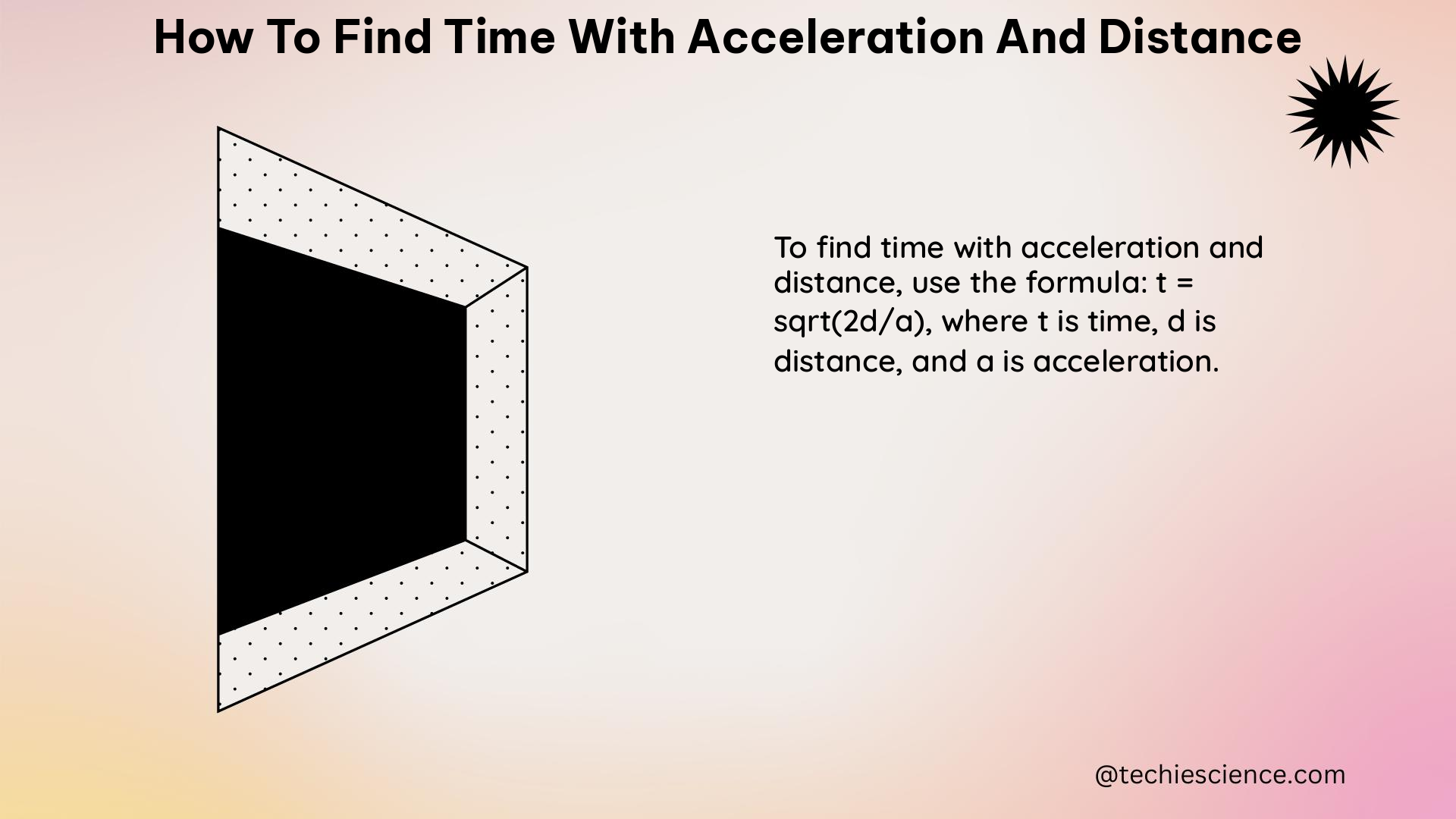Summary
To find the time taken for an object to travel a certain distance with a given acceleration, you can use the formula: t = √((2d)/a) - (v₀/a), where t is the time, d is the distance, a is the acceleration, and v₀ is the initial velocity. If the initial velocity is zero, the formula simplifies to t = √((2d)/a). This guide will provide a detailed explanation of the formula, its derivation, and practical examples to help you master the concept of finding time with acceleration and distance.
Understanding the Formula

The formula to find time with acceleration and distance is derived from the equations of motion, which describe the relationship between an object’s position, velocity, and acceleration over time. The formula is:
t = √((2d)/a) - (v₀/a)
Where:
– t is the time (in seconds)
– d is the distance (in meters)
– a is the acceleration (in meters per second squared)
– v₀ is the initial velocity (in meters per second)
If the initial velocity is zero, the formula simplifies to:
t = √((2d)/a)
This formula assumes that the acceleration is constant throughout the motion, which is often the case in physics problems.
Derivation of the Formula
The formula can be derived from the equations of motion, which are:
v = v₀ + atd = v₀t + (1/2)at²
Rearranging the second equation, we get:
t = √((2d)/a) - (v₀/a)
This is the formula for finding the time with acceleration and distance.
Assumptions and Limitations
The formula assumes that:
– The acceleration is constant throughout the motion.
– The initial velocity is known or can be assumed to be zero.
If these assumptions are not met, the formula may not provide accurate results. In such cases, you may need to use more complex equations of motion or numerical methods to find the time.
Practical Examples
Let’s consider some practical examples to illustrate the use of the formula.
Example 1: Calculating Time with Constant Acceleration
Suppose an object is traveling a distance of 1,000,000 meters with a constant acceleration of 10 meters per second squared, and the initial velocity is zero.
Using the formula:
t = √((2d)/a)
t = √((2 × 1,000,000)/10)
t = 632.46 seconds
Therefore, the time taken for the object to travel 1,000,000 meters with a constant acceleration of 10 meters per second squared and an initial velocity of zero is 632.46 seconds.
Example 2: Calculating Time with Non-zero Initial Velocity
Now, let’s consider a scenario where the initial velocity is not zero.
Suppose an object is traveling a distance of 500 meters with a constant acceleration of 5 meters per second squared, and the initial velocity is 20 meters per second.
Using the formula:
t = √((2d)/a) - (v₀/a)
t = √((2 × 500)/5) - (20/5)
t = 10 seconds - 4 seconds
t = 6 seconds
Therefore, the time taken for the object to travel 500 meters with a constant acceleration of 5 meters per second squared and an initial velocity of 20 meters per second is 6 seconds.
Example 3: Calculating Time with Varying Acceleration
In some cases, the acceleration may not be constant throughout the motion. Let’s consider an example where the acceleration varies.
Suppose an object is traveling a distance of 1,000 meters with an initial velocity of 10 meters per second. The acceleration starts at 5 meters per second squared for the first 500 meters, and then changes to 10 meters per second squared for the remaining 500 meters.
In this case, you would need to split the motion into two parts and use the formula for each part separately. The total time would be the sum of the times for the two parts.
For the first 500 meters:
t₁ = √((2 × 500)/5) - (10/5)
t₁ = 10 seconds - 2 seconds
t₁ = 8 seconds
For the remaining 500 meters:
t₂ = √((2 × 500)/10) - (18/10) (where 18 is the final velocity from the first part)
t₂ = 5 seconds - 1.8 seconds
t₂ = 3.2 seconds
The total time is the sum of the two parts:
t = t₁ + t₂
t = 8 seconds + 3.2 seconds
t = 11.2 seconds
Therefore, the total time taken for the object to travel 1,000 meters with varying acceleration is 11.2 seconds.
Conclusion
In this comprehensive guide, we have explored the formula for finding time with acceleration and distance, its derivation, and practical examples to help you understand the concept better. Remember, the formula assumes constant acceleration and known initial velocity, and if these assumptions are not met, you may need to use more complex equations or numerical methods to find the time.
By mastering the use of this formula, you will be able to solve a wide range of physics problems involving motion and time, which is essential for students and professionals in various scientific and engineering fields.
Reference:
- How to calculate time from constant acceleration without final velocity?
- Physics Formulas for Distance, Velocity, and Time
- Equations of Motion
I am Shambhu Patil, a physics enthusiast. I have done M.Sc. in Physics. Physics always intrigues me and makes me think about, how this universe works. I have an interest in nuclear physics, quantum mechanics, and thermodynamics. I am very good at problem-solving and explaining complex physical phenomena in simple language. My articles will walk you through each and every concept in detail.